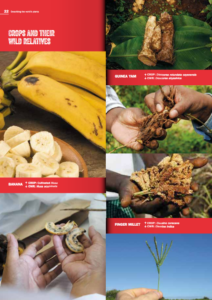- Disease risk perception and diversity of management strategies by farmers: The case of anthracnose caused by Colletotrichum gloeosporioides on water yams (Dioscorea alata) in Guadeloupe. Farmers gauge the disease pretty much the way scientists do, and use a diversity of mitigation measures, including diversity.
- Ghosts of Cultivation Past – Native American Dispersal Legacy Persists in Tree Distribution. “In the southern Appalachian region, honey locust distributions are more a reflection of Native American cultural practices.”
- Good year, bad year: changing strategies, changing networks? A two-year study on seed acquisition in northern Cameroon. In bad years, women call on extended networks.
- Conservation narratives in Peru: envisioning biodiversity in sustainable development. In terms of the relationship between conservation and development, there are biodiversity protectionists, traditionalists, localists, pragmatists, and capitalists.
- Diversity analysis based on agro-morphological traits and microsatellite based markers in global germplasm collections of roselle (Hibiscus sabdariffa L.). Nicely complementary datasets show that fibre type more diverse than calyx type.
- Extinction probabilities of Hassawi cattle from Saudi Arabia using Population Viability Analysis. Fancy maths gives it 20 years.
- Genome to Phenome Mapping in Apple Using Historical Data. Going back to old phenotype data in GRIN allowed identification of SNPs for color, fruit firmness, and harvest time.
- Genomic and archaeological evidence suggest a dual origin of domestic dogs. Independent domestications from different wolf populations in East Asia and in Western Europe, with the latter partially displacing the former.
CWR front and centre
 To coincide with the State of the World’s Plants Symposium, which starts today, Kew have just dropped a monumental report of the same name, complete with fancy website. Nice to see crop wild relatives get a decent amount of space (p. 21) in the section on useful plants. Oh, and the report and symposium come along with some good funding news for Kew.
To coincide with the State of the World’s Plants Symposium, which starts today, Kew have just dropped a monumental report of the same name, complete with fancy website. Nice to see crop wild relatives get a decent amount of space (p. 21) in the section on useful plants. Oh, and the report and symposium come along with some good funding news for Kew.
Speaking of funding for crop wild relatives:
The International Union for Conservation of Nature (IUCN) and Toyota Motor Corporation (Toyota) today announced a five-year partnership to provide funding to broaden the scope of The IUCN Red List of Threatened Species. This will significantly increase knowledge on the extinction risk of more than 28,000 species, including many that are key food sources for a significant portion of the global population.
…
IUCN experts have chosen to focus much of the newly funded research on the populations of plants and fish that billions of people depend on as a vital source of food. These will include species of wild rice and wheat that are crucial to food security because they are the source of genetic material used to increase the yield, fertility and resistance to disease of staple crops produced by farmers across the world.
Don’t see any of this happening even a few years back. Do you?
Prof Kathy Willis @kewgardens @KewScience putting #plants on the map #SOTWP pic.twitter.com/g45pTxZPfk
— David Cope (@DrDrCope) May 11, 2016
Nibbles: Fixing food, Diane Medal, Iraq Edens, Camel genetics, Disappearing horses
- UNEP video on why we have to change the food system.
- Garden Club of America honors breadfruit guru Diane Ragone.
- Paradise spared. In Iraq.
- No such thing as an isolated dromedary, DNA says.
- Horses in Kazakhstan, on the other hand…
Nibbles: Coffee strategy, Agroforestry, Superfoods, Cyperus, Potato history, Precious tea, Wheat disease, Crowdfunding conservation
- Strategizing about coffee. Over cappuccinos, I suspect.
- Treesilience. I like that.
- Enough with the superfoods already.
- Which is not something anybody ever called tiger nuts.
- You can now officially blame the potato for the fall of civilization.
- A really expensive cup of tea.
- Wheat blast reaches Asia.
- Crowdfunding tree conservation on Hawaii.
Brainfood: Lupine seeds, Bangladeshi rice, Biscay anchovy, Sweet cassava, Ancient vetches, Salty adzuki, Maroon crops, Mungbean cores, Cassava genome
- Evaluation of thermal, chemical, and mechanical seed scarification methods for 4 Great Basin lupine species. They all need different things.
- Exploring novel genetic sources of salinity tolerance in rice through molecular and physiological characterization. A lot of salt-tolerant Bangladeshi landraces cluster together in an aromatic group close to japonica.
- No loss of genetic diversity in the exploited and recently collapsed population of Bay of Biscay anchovy (Engraulis encrasicolus L.). Effective population size has remained steady, irrespective of census population size.
- Molecular characterization of accessions of a rare genetic resource: sugary cassava (Manihot esculenta Crantz) from Brazilian Amazon. Two distinct genetic groups.
- Presence of vetches (Vicia spp.) in agricultural and wild floras of ancient Europe. One of the proto-IndoEuropean roots for the collective name of these things translates as “avoid”.
- Salt tolerance in wild relatives of adzuki bean, Vigna angularis (Willd.) Ohwi et Ohashi. Two crossable wild relatives had different salt tolerance mechanisms.
- The ‘Botanical Gardens of the Dispossessed’ revisited: richness and significance of Old World crops grown by Suriname Maroons. Some crops are only used in rituals now. But even that’s pretty cool, and better than nothing.
- The AVRDC–The World Vegetable Center mungbean (Vigna radiata) core and mini core collections. 1481 (20% of total) accessions chosen by geography and phenotype, then 289 by SSRs.
- Sequencing wild and cultivated cassava and related species reveals extensive interspecific hybridization and genetic diversity. And you can also use the results for rubber!